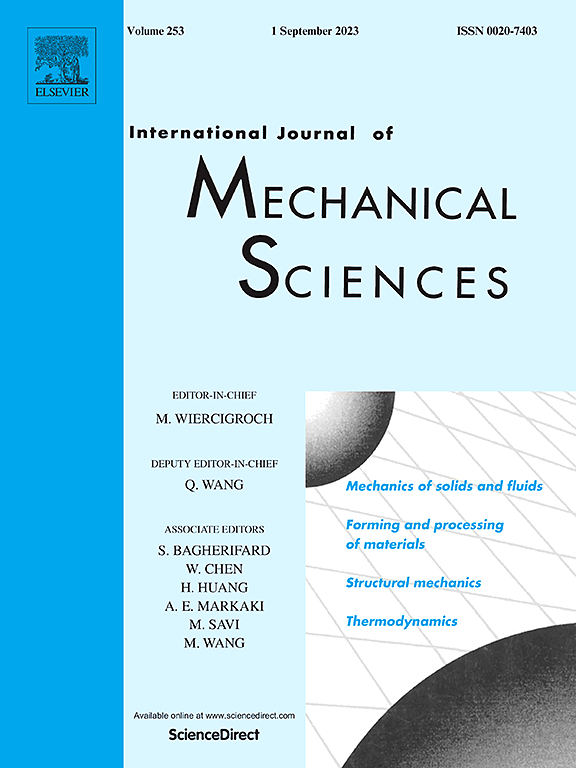Vibration model modification of fluted sandwich cylindrical shells
IF 7.1
1区 工程技术
Q1 ENGINEERING, MECHANICAL
International Journal of Mechanical Sciences
Pub Date : 2025-07-16
DOI:10.1016/j.ijmecsci.2025.110606
引用次数: 0
Abstract
Focusing on the current state of research on the rough theoretical modelling of fluted cylindrical shell structures that can be used as lightweight engineering components, the present study aims to overcome the unreasonable geometric feature characterization, inaccurate equivalent density, and crude equivalent modulus approximation of the cylindrical fluted core in existing models by employing rigorous theoretical derivations. For the first time, a revised vibration model is proposed in the present work to achieve higher precision prediction outcomes for the natural frequency and impulse response of fluted sandwich cylindrical shells. In addition, the constraint forms of boundary conditions are enriched via the virtual spring skill, and specific constraint conditions are relaxed to a continuous elastic constraint state to facilitate the various boundary simulations. The theoretical framework is constructed, the standardized characterizations of the geometrical features of the cylindrical fluted core are regulated, and the exact equivalent density calculation formulas are determined, with the elastic moduli being improved and corrected. Relying on the first-order shear deformation theory and the generalized Hooke's law, the displacement fields and constitutive relations of fluted sandwich cylindrical shells are established, and the dynamic equations are derived through the Rayleigh-Ritz method, with the eigenvalues and eigenfunctions solved therein to obtain the natural frequencies and mode shapes. The transient responses under the triangular, rectangular, exponential, and half-sine impulse excitations are formulated by the Newmark-Beta numerical path. The desired model parameters and their selection criteria are extracted from conducting the convergence analysis, and the numerical validations are then carried out by comparing the calculation results of the proposed model with full-size finite element simulations, and the errors of the uncorrected model results and the numerical advantages of the corrected model are quantified. The influencing laws of key configuration changes on the frequency and response manifestations of such structures are revealed, which can contribute to citation benchmarks and design references for subsequent research.带槽夹层圆柱壳振动模型修正
针对目前工程轻量化构件带槽圆柱壳结构粗略理论建模的研究现状,通过严格的理论推导,克服现有模型中圆柱带槽芯几何特征表征不合理、等效密度不准确、等效模量近似粗糙等问题。本文首次提出了一种修正的振动模型,对带槽夹层圆柱壳的固有频率和冲击响应进行了更高精度的预测。此外,通过虚拟弹簧技术丰富了边界条件的约束形式,将特定约束条件松弛为连续弹性约束状态,便于各种边界模拟。建立了理论框架,规范了圆柱槽芯几何特征的标准化表征,确定了精确的等效密度计算公式,并对弹性模量进行了改进和修正。基于一阶剪切变形理论和广义Hooke定律,建立了带槽夹层圆柱壳的位移场和本构关系,采用瑞利-里兹法推导了壳的动力方程,求解了壳的本征值和本征函数,得到了壳的固有频率和振型。三角形、矩形、指数和半正弦脉冲激励下的瞬态响应由Newmark-Beta数值路径表示。通过收敛分析提取所需的模型参数及其选择准则,并将所提模型的计算结果与全尺寸有限元仿真结果进行对比,进行数值验证,量化未校正模型结果的误差和校正模型的数值优势。揭示了关键构型变化对该类结构频率和响应表现的影响规律,为后续研究提供了引用基准和设计参考。
本文章由计算机程序翻译,如有差异,请以英文原文为准。
求助全文
约1分钟内获得全文
求助全文
来源期刊

International Journal of Mechanical Sciences
工程技术-工程:机械
CiteScore
12.80
自引率
17.80%
发文量
769
审稿时长
19 days
期刊介绍:
The International Journal of Mechanical Sciences (IJMS) serves as a global platform for the publication and dissemination of original research that contributes to a deeper scientific understanding of the fundamental disciplines within mechanical, civil, and material engineering.
The primary focus of IJMS is to showcase innovative and ground-breaking work that utilizes analytical and computational modeling techniques, such as Finite Element Method (FEM), Boundary Element Method (BEM), and mesh-free methods, among others. These modeling methods are applied to diverse fields including rigid-body mechanics (e.g., dynamics, vibration, stability), structural mechanics, metal forming, advanced materials (e.g., metals, composites, cellular, smart) behavior and applications, impact mechanics, strain localization, and other nonlinear effects (e.g., large deflections, plasticity, fracture).
Additionally, IJMS covers the realms of fluid mechanics (both external and internal flows), tribology, thermodynamics, and materials processing. These subjects collectively form the core of the journal's content.
In summary, IJMS provides a prestigious platform for researchers to present their original contributions, shedding light on analytical and computational modeling methods in various areas of mechanical engineering, as well as exploring the behavior and application of advanced materials, fluid mechanics, thermodynamics, and materials processing.
 求助内容:
求助内容: 应助结果提醒方式:
应助结果提醒方式:


